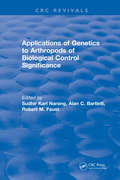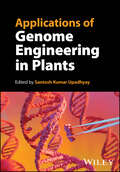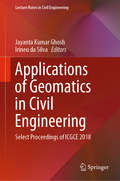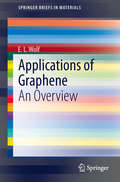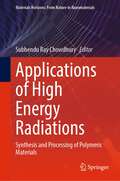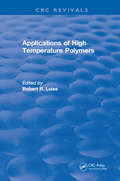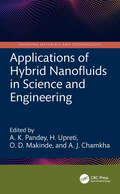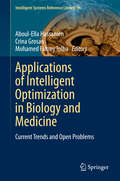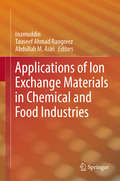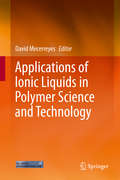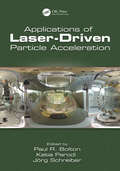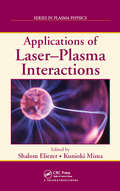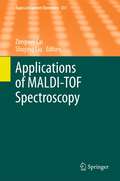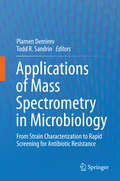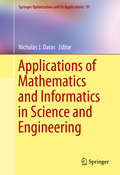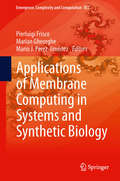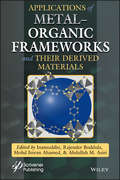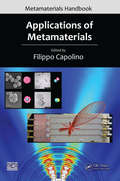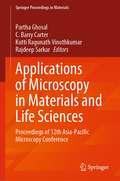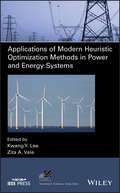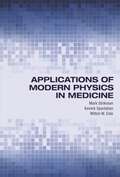- Table View
- List View
Applications of Genetics to Arthropods of Biological Control Significance
by Sudhir Karl NarangWritten by experts in the fields of insect pest genetics, the genetics of biological control organisms, and the application of biological control, this book provides the first up-to-date summary of the genetic literature on the genetics of arthropod biological control agents. It identifies successful programs and also gaps and needs in research, research constraints, and possible research approaches in this important field of pest control. The power and applicability of new genetic and molecular biology methods have created new and exciting possibilities to greatly improve the effectiveness of traditional biological control programs. This book provides essential information about the state-of-the-art application of these new methods. It explains how biological control procedures can be improved, covers methods for selecting pesticide-resistant strains of natural enemies, and looks at methods for maintaining genetic diversity and quality control during the rearing of biological control agents in the laboratory. The book also provides information regarding the application of powerful PCR methods for taxonomic identification of strains and species of biocontrol agents.
Applications of Genome Engineering in Plants
by Santosh Kumar UpadhyayApplications of Genome Engineering in Plants Understand the keys to creating the food of the future Genome engineering in plants is a field that has made enormous strides in recent years. In particular, the CRISPR-Cas system has been used in a number of crop species to make significant leaps forward in nutritional improvement, stress tolerance, crop yield, and more. As scientists work to meet global food needs and foster sustainable agriculture in a changing world, genome engineering promises only to become more important. Applications of Genome Engineering in Plants details the history of, and recent developments in, this essential area of biotechnology. It describes advances enabling nutritional improvement, nutraceuticals improvement, flavonoid enrichment, and many more crop enhancements, as well as subjects such as biosafety and regulatory mechanisms. The result is a thorough and essential overview for researchers and biotech professionals. Applications of Genome Engineering in Plants readers will also find: Chapters on trans-gene free editing or non-transgenic approaches to plant genomes Detailed discussion of topics including nanotechnology-facilitated genome editing, engineering for virus resistance in plants, and more Applications of genome editing in oil seed crops, vegetables, ornamental plants, and many others Applications of Genome Engineering in Plants is ideal for academics, scientists, and industry professionals working in biotechnology, agriculture, food science, and related subjects.
Applications of Geomatics in Civil Engineering: Select Proceedings of ICGCE 2018 (Lecture Notes in Civil Engineering #33)
by Jayanta Kumar Ghosh Irineu Da SilvaThis book comprises select proceedings of the First International Conference on Geomatics in Civil Engineering (ICGCE 2018). This book presents latest research on applications of geomatics engineering in different domains of civil engineering, like structural engineering, geotechnical engineering, hydraulic and water resources engineering, environmental engineering and transportation engineering. It also covers miscellaneous applications of geomatics in a wide range of technical and societal problems making use of geospatial information, engineering principles, and relational data structures involving measurement sciences. The book proves to be very useful for the scientific and engineering community working in the field of geomatics and geospatial technology.
Applications of Graphene: An Overview (SpringerBriefs in Materials)
by E. L. WolfGraphene is presented and analyzed as a replacement for silicon. The Primary focus is on solar cell and CMOS device technologies, with attention to the fabrication methods, including extensions needed, in each case. Specialized applications for graphene within the existing silicon technology are discussed and found to be promising.
Applications of Group Theory in Quantum Mechanics (Dover Books on Physics)
by M. I. Petrashen J. L. TrifonovGeared toward postgraduate students, theoretical physicists, and researchers, this advanced text explores the role of modern group-theoretical methods in quantum theory. The authors based their text on a physics course they taught at a prominent Soviet university. Readers will find it a lucid guide to group theory and matrix representations that develops concepts to the level required for applications.The text's main focus rests upon point and space groups, with applications to electronic and vibrational states. Additional topics include continuous rotation groups, permutation groups, and Lorentz groups. A number of problems involve studies of the symmetry properties of the Schroedinger wave function, as well as the explanation of "additional" degeneracy in the Coulomb field and certain subjects in solid-state physics. The text concludes with an instructive account of problems related to the conditions for relativistic invariance in quantum theory.
Applications of Group Theory to Atoms, Molecules, and Solids
by Thomas Wolfram nas Ell altio luThe majority of all knowledge concerning atoms, molecules, and solids has been derived from applications of group theory. Taking a unique, applications-oriented approach, this book gives readers the tools needed to analyze any atomic, molecular, or crystalline solid system. Using a clearly defined, eight-step program, this book helps readers to understand the power of group theory, what information can be obtained from it, and how to obtain it. The book takes in modern topics, such as graphene, carbon nanotubes and isotopic frequencies of molecules, as well as more traditional subjects: the vibrational and electronic states of molecules and solids, crystal field and ligand field theory, transition metal complexes, space groups, time reversal symmetry, and magnetic groups. With over 100 end-of-chapter exercises, this book is invaluable for graduate students and researchers in physics, chemistry, electrical engineering and materials science.
Applications of High Energy Radiations: Synthesis and Processing of Polymeric Materials (Materials Horizons: From Nature to Nanomaterials)
by Subhendu Ray ChowdhuryThis book presents the applications of high-energy beam radiation for synthesis and processing of polymeric materials. It addresses fundamental nature of high energy i.e., ionizing radiations and interaction with monomers and polymers leading to a wide variety of products such as tyres, textiles, shape memory polymers, polymers for aviation and space applications, polymeric biomaterials and natural rubber latex. It discusses general principles and techniques of preparation of polymeric materials including polymer blends, composites and nanocomposites. It also includes the topic of radiation-assisted recycling of polymers through breaking of covalent bonds. This book will be useful for students, researchers and professionals in the areas of polymers science and technology, radiation technology, electron beam technology, gamma radiation technology, advanced materials technology, biomaterials technology, nanotechnology, membrane science technology and environmental science.
Applications of High Temperature Polymers
by Robert R. LuiseA gathering of leading experts in the field of high temperature polymers unite in this exciting compilation to discuss applications and marketing projections in this ever-expanding field. The authors represent a diverse group of academicians, industrial researchers, consultants, managers, and marketing forecasters and present a broad-based view of polymer technology.Topics include: liquid crystalline polymers; high temperature polyimides; heat-resistant engineering polymers; and high temperature organic polymers, including their chemistry and key functional properties in moldings, films, fibers, and coatings, as well as applications in electronics, packaging, and friction/wear. This is an essential source of data on high temperature polymers.
Applications of Hybrid Nanofluids in Science and Engineering (Emerging Materials and Technologies)
by O. D. Makinde A. K. Pandey H. Upreti A. J. ChamkhaApplications of Hybrid Nanofluids in Science and Engineering delves deep into the multifaceted realms in which these dynamic fluids are playing a pivotal role in various fields.This comprehensive volume elucidates the diverse applications and promising potentials of hybrid nanofluids. It introduces hybrid nanofluids and their preparation methods, thermophysical properties, advantages, applications, and future scope. Models to compute the effective thermophysical properties of hybrid nanofluids are also discussed, along with their limitations. In the application section, mathematical models are formulated to contemplate the flow of hybrid nanofluids through different surfaces/geometries under different situations. Also, the entropy generation minimization in hybrid nanofluid flow is discussed with its application in refrigeration, power generation, and other processes.The subject matter in this book will enable the reader to do the following: Learn the ins and outs of hybrid nanofluids—from how they are made to the special characteristics they embody Explore hybrid nanofluids' potential in thermal management, energy systems, materials science, biomedical engineering, and more Use advanced computational and analytical methods to analyse complex fluid dynamics models Anticipate the impact of hybrid nanofluid research on upcoming sectors like renewable energy and innovative manufacturing This book is aimed at researchers and graduate students in mechanical and chemical engineering and materials science.
Applications of Intelligent Optimization in Biology and Medicine: Current Trends and Open Problems (Intelligent Systems Reference Library #96)
by Aboul-Ella Hassanien Crina Grosan Mohamed Fahmy TolbaThis volume provides updated, in-depth material on the application of intelligent optimization in biology and medicine. The aim of the book is to present solutions to the challenges and problems facing biology and medicine applications. This Volume comprises of 13 chapters, including an overview chapter, providing an up-to-date and state-of-the research on the application of intelligent optimization for bioinformatics applications, DNA based Steganography, a modified Particle Swarm Optimization Algorithm for Solving Capacitated Maximal Covering Location Problem in Healthcare Systems, Optimization Methods for Medical Image Super Resolution Reconstruction and breast cancer classification. Moreover, some chapters that describe several bio-inspired approaches in MEDLINE Text Mining, DNA-Binding Proteins and Classes, Optimized Tumor Breast Cancer Classification using Combining Random Subspace and Static Classifiers Selection Paradigms, and Dental Image Registration. The book will be a useful compendium for a broad range of readers--from students of undergraduate to postgraduate levels and also for researchers, professionals, etc. --who wish to enrich their knowledge on Intelligent Optimization in Biology and Medicine and applications with one single book.
Applications of Ion Exchange Materials in Chemical and Food Industries
by Inamuddin Abdullah M. Asiri Tauseef Ahmad RangreezThis book presents the applications of ion-exchange materials in the chemical and food industries. It includes topics related to the application of ion exchange chromatography in water softening, purification and separation of chemicals, separation and purification of food products and catalysis. This title is a highly valuable source of knowledge on ion-exchange materials and their applications suitable for postgraduate students and researchers but also to industrial R&D specialists in chemistry, chemical, and biochemical technology. Additionally, this book will provide an in-depth knowledge of ion-exchange column and operations suitable for engineers and industrialists.
Applications of Ionic Liquids in Polymer Science and Technology
by David MecerreyesThis book summarizes the latest knowledge in the science and technology of ionic liquids and polymers in different areas. Ionic liquids (IL) are actively being investigated in polymer science and technology for a number of different applications. In the first part of the book the authors present the particular properties of ionic liquids as speciality solvents. The state-of-the art in the use of ionic liquids in polymer synthesis and modification reactions including polymer recycling is outlined. The second part focuses on the use of ionic liquids as speciality additives such as plasticizers or antistatic agents. The third part examines the use of ionic liquids in the design of functional polymers (usually called polymeric ionic liquids (PIL) or poly(ionic liquids)). Many important applications in diverse scientific and industrial areas rely on these polymers, like polymer electrolytes in electrochemical devices, building blocks in materials science, nanocomposites, gas membranes, innovative anion sensitive materials, smart surfaces, and a countless set range of emerging applications in different fields such as energy, optoelectronics, analytical chemistry, biotechnology, nanomedicine or catalysis.
Applications of Laser-Driven Particle Acceleration
by Paul Bolton Katia Parodi Jörg SchreiberThe first book of its kind to highlight the unique capabilities of laser-driven acceleration and its diverse potential, Applications of Laser-Driven Particle Acceleration presents the basic understanding of acceleration concepts and envisioned prospects for selected applications. As the main focus, this new book explores exciting and diverse application possibilities, with emphasis on those uniquely enabled by the laser driver that can also be meaningful and realistic for potential users. It also emphasises distinction, in the accelerator context, between laser-driven accelerated particle sources and the integrated laser-driven particle accelerator system (all-optical and hybrid versions). A key aim of the book is to inform multiple, interdisciplinary research communities of the new possibilities available and to inspire them to engage with laser-driven acceleration, further motivating and advancing this developing field. Material is presented in a thorough yet accessible manner, making it a valuable reference text for general scientific and engineering researchers who are not necessarily subject matter experts. Applications of Laser-Driven Particle Acceleration is edited by Professors Paul R. Bolton, Katia Parodi, and Jörg Schreiber from the Department of Medical Physics at the Ludwig-Maximilians-Universität München in München, Germany. Features: Reviews the current understanding and state-of-the-art capabilities of laser-driven particle acceleration and associated energetic photon and neutron generation Presents the intrinsically unique features of laser-driven acceleration and particle bunch yields Edited by internationally renowned researchers, with chapter contributions from global experts
Applications of Laser-Plasma Interactions
by Shalom Eliezer Kunioki MimaRecent advances in the development of lasers with more energy, power, and brightness have opened up new possibilities for exciting applications. Applications of Laser-Plasma Interactions reviews the current status of high power laser applications. The book first explores the science and technology behind the ignition and burn of imploded fusion fue
Applications of MALDI-TOF Spectroscopy (Topics in Current Chemistry #331)
by Zongwei Cai Shuying LiuMALDI-ToF Mass Spectrometry for Studying Noncovalent Complexes of Biomolecules, by Stefanie Mädler, Elisabetta Boeri Erba, Renato Zenobi Application of MALDI-TOF-Mass Spectrometry to Proteome Analysis Using Stain-Free Gel Electrophoresis, by Iuliana Susnea, Bogdan Bernevic, Michael Wicke, Li Ma, Shuying Liu, Karl Schellander, Michael Przybylski MALDI Mass Spectrometry for Nucleic Acid Analysis, by Xiang Gao, Boon-Huan Tan, Richard J. Sugrue, Kai Tang Determination of Peptide and Protein Disulfide Linkages by MALDI Mass Spectrometry, by Hongmei Yang, Ning Liu, Shuying Liu MALDI In-Source Decay, from Sequencing to Imaging, by Delphine Debois, Nicolas Smargiasso, Kevin Demeure, Daiki Asakawa, Tyler A. Zimmerman, Loïc Quinton, Edwin De Pauw Advances of MALDI-TOF MS in the Analysis of Traditional Chinese Medicines, by Minghua Lu, Zongwei Cai Chemical and Biochemical Applications of MALDI TOF-MS Based on Analyzing the Small Organic Compounds, by Haoyang Wang, Zhixiong Zhao, Yinlong Guo Bioinformatic Analysis of Data Generated from MALDI Mass Spectrometry for Biomarker Discovery, by Zengyou He, Robert Z. Qi, Weichuan Yu
Applications of Machine Learning in Hydroclimatology (The Springer Series in Applied Machine Learning)
by Roshan Srivastav Purna C. NayakApplications of Machine Learning in Hydroclimatology is a comprehensive exploration of the transformative potential of machine learning for addressing critical challenges in water resources management. The book explores how artificial intelligence can unravel the complexities of hydrological systems, providing researchers and practitioners with cutting-edge tools to model, predict, and manage these systems with greater precision and effectiveness. It thoroughly examines the modeling of hydrometeorological extremes, such as floods and droughts, which are becoming increasingly difficult to predict due to climate change. By leveraging AI-driven methods to forecast these extremes, the book offers innovative approaches that enhance predictive accuracy. It emphasizes the importance of analyzing non-stationarity and uncertainty in a rapidly evolving climate landscape, illustrating how statistical and frequency analyses can improve hydrological forecasts. Moreover, the book explores the impact of climate change on flood risks, drought occurrences, and reservoir operations, providing insights into how these phenomena affect water resource management. To provide practical solutions, the book includes case studies that showcase effective mitigation measures for water-related challenges. These examples highlight the use of machine learning techniques such as deep learning, reinforcement learning, and statistical downscaling in real-world scenarios. They demonstrate how artificial intelligence can optimize decision-making and resource management while improving our understanding of complex hydrological phenomena. By utilizing machine learning architectures tailored to hydrology, the book presents physics-guided models, data-driven techniques, and hybrid approaches that can be used to address water management issues. Ultimately, Applications of Machine Learning in Hydroclimatology empowers researchers, practitioners, and policymakers to harness machine learning for sustainable water management. It bridges the gap between advanced AI technologies and hydrological science, offering innovative solutions to tackle today's most pressing challenges in water resources.
Applications of Mass Spectrometry in Microbiology: From Strain Characterization to Rapid Screening for Antibiotic Resistance
by Plamen Demirev Todd R. SandrinIn the last quarter century, advances in mass spectrometry (MS) have been at the forefront of efforts to map complex biological systems including the human metabolome, proteome, and microbiome. All of these developments have allowed MS to become a well-established molecular level technology for microorganism characterization. MS has demonstrated its considerable advantage as a rapid, accurate, and cost-effective method for microorganism identification, compared to conventional phenotypic techniques. In the last several years, applications of MS for microorganism characterization in research, clinical microbiology, counter-bioterrorism, food safety, and environmental monitoring have been documented in thousands of publications. Regulatory bodies in Europe, the US, and elsewhere have approved MS-based assays for infectious disease diagnostics. As of mid-2015, more than 3300 commercial MS systems for microorganism identification have been deployed worldwide in hospitals and clinical labs. While previous work has covered broader approaches in using MS to characterize microorganisms at the species level or above, this book focuses on strain-level and subtyping applications. In twelve individual chapters, innovators, leaders and practitioners in the field from around the world have contributed to a comprehensive overview of current and next-generation approaches for MS-based microbial characterization at the subspecies and strain levels. Chapters include up-to-date reference lists as well as web-links to databases, recommended software, and other useful tools. The emergence of new, antibiotic-resistant strains of human or animal pathogens is of extraordinary concern not only to the scientific and medical communities, but to the general public as well. Developments of novel MS-based assays for rapid identification of strains of antibiotic-resistant microorganisms are reviewed in the book as well. Microbiologists, bioanalytical scientists, infectious disease specialists, clinical laboratory and public health practitioners as well as researchers in universities, hospitals, government labs, and the pharmaceutical and biotechnology industries will find this book to be a timely and valuable resource.
Applications of Mathematics and Informatics in Science and Engineering (Springer Optimization and Its Applications #91)
by Nicholas J. DarasAnalysis, assessment, and data management are core competencies for operation research analysts. This volume addresses a number of issues and developed methods for improving those skills. It is an outgrowth of a conference held in April 2013 at the Hellenic Military Academy and brings together a broad variety of mathematical methods and theories with several applications. It discusses directions and pursuits of scientists that pertain to engineering sciences. It is also presents the theoretical background required for algorithms and techniques applied to a large variety of concrete problems. A number of open questions as well as new future areas are also highlighted. This book will appeal to operations research analysts, engineers, community decision makers, academics, the military community, practitioners sharing the current "state-of-the-art," and analysts from coalition partners. Topics covered include Operations Research, Games and Control Theory, Computational Number Theory and Information Security, Scientific Computing and Applications, Statistical Modeling and Applications, Systems of Monitoring and Spatial Analysis.
Applications of Membrane Computing in Systems and Synthetic Biology (Emergence, Complexity and Computation #7)
by Pierluigi Frisco Marian Gheorghe Mario J. Pérez-JiménezMembrane Computing was introduced as a computational paradigm in Natural Computing. The models introduced, called Membrane (or P) Systems, provide a coherent platform to describe and study living cells as computational systems. Membrane Systems have been investigated for their computational aspects and employed to model problems in other fields, like: Computer Science, Linguistics, Biology, Economy, Computer Graphics, Robotics, etc. Their inherent parallelism, heterogeneity and intrinsic versatility allow them to model a broad range of processes and phenomena, being also an efficient means to solve and analyze problems in a novel way. Membrane Computing has been used to model biological systems, becoming with time a thorough modeling paradigm comparable, in its modeling and predicting capabilities, to more established models in this area. This book is the result of the need to collect, in an organic way, different facets of this paradigm. The chapters of this book, together with the web pages accompanying them, present different applications of Membrane Systems to Biology. Deterministic, non-deterministic and stochastic systems paired with different algorithms and methodologies show the full potential of this framework. The book is addressed to researchers interested in applications of discrete biological models and the interplay between Membrane Systems and other approaches to analyze complex systems.
Applications of Metal-Organic Frameworks and Their Derived Materials
by Abdullah M. Asiri Mohd Imran Ahamed Rajender Boddula InamuddinMetal–organic frameworks (MOFs) are porous crystalline polymers constructed by metal sites and organic building blocks. Since the discovery of MOFs in the 1990s, they have received tremendous research attention for various applications due to their high surface area, controllable morphology, tunable chemical properties, and multifunctionalities, including MOFs as precursors and self-sacrificing templates for synthesizing metal oxides, heteroatom-doped carbons, metal-atoms encapsulated carbons, and others. Thus, awareness and knowledge about MOFs and their derived nanomaterials with conceptual understanding are essential for the advanced material community. This breakthrough new volume aims to explore down-to-earth applications in fields such as biomedical, environmental, energy, and electronics. This book provides an overview of the structural and fundamental properties, synthesis strategies, and versatile applications of MOFs and their derived nanomaterials. It gives an updated and comprehensive account of the research in the field of MOFs and their derived nanomaterials. Whether as a reference for industry professionals and nanotechnologists or for use in the classroom for graduate and postgraduate students, faculty members, and research and development specialists working in the area of inorganic chemistry, materials science, and chemical engineering, this is a must-have for any library.
Applications of Metamaterials (Metamaterials Handbook)
by Filippo CapolinoThis book uses the first volume’s exploration of theory, basic properties, and modeling topics to develop readers’ understanding of applications and devices that are based on artificial materials. It explores a wide range of applications in fields including electronics, telecommunications, sensing, medical instrumentation, and data storage. The text also includes a practical user’s guide and explores key areas in which artificial materials have developed. It includes experts’ perspectives on current and future applications of metamaterials, to present a well-rounded view on state-of-the-art technologies.
Applications of Microfluidic Systems in Biology and Medicine (Bioanalysis #13)
by Manabu TokeshiThis book is the second edition of the one originally published in 2016, which focused on state-of-the-art microfluidic research in medical and biological applications. Similar to the first edition, beginners in the field —undergraduates, engineers, biologists, medical and pharmaceutical researchers—will easily learn to understand microfluidic-based medical and biological applications. Because a wide range of topics is summarized here, it also helps experts to learn more about fields outside their own specialties. In this second edition, significant revisions have been made to chapters covering technologies that have seen major advancements, such as acoustofluidics, protein crystallography, organ-on-a-chip systems, nanopore sensing, and paper-based microfluidics. In addition, the chapters on cancer diagnosis using exosomes and single-cell sequencing using droplet microfluidics, which are attracting attention as new technologies, have been newly added. Readers will be convinced that microfluidic devices have great potential for medical and biological applications.
Applications of Microscopy in Materials and Life Sciences: Proceedings of 12th Asia-Pacific Microscopy Conference (Springer Proceedings in Materials #11)
by C. Barry Carter Partha Ghosal Kutti Ragunath Vinothkumar Rajdeep SarkarThis book comprises the proceedings of the 12th International Conference on Asia-Pacific Microscopy Conference (APMC12) focusing on emerging opportunities and challenges in the field of materials sciences, life sciences and microscopy techniques. The contents of this volume include papers on aberration corrected TEM & STEM, SEM – FIB, ion beam microscopy, electron diffraction & crystallography, microscopy and imaging associated with bio-nanotechnology, medical applications, host-pathogen interaction, etc. This book will be beneficial to researchers, educators, and practitioners alike.
Applications of Modern Heuristic Optimization Methods in Power and Energy Systems (IEEE Press Series on Power Engineering)
by Kwang Y. Lee Zita A. ValeReviews state-of-the-art technologies in modern heuristic optimization techniques and presents case studies showing how they have been applied in complex power and energy systems problems Written by a team of international experts, this book describes the use of metaheuristic applications in the analysis and design of electric power systems. This includes a discussion of optimum energy and commitment of generation (nonrenewable & renewable) and load resources during day-to-day operations and control activities in regulated and competitive market structures, along with transmission and distribution systems. Applications of Modern Heuristic Optimization Methods in Power and Energy Systems begins with an introduction and overview of applications in power and energy systems before moving on to planning and operation, control, and distribution. Further chapters cover the integration of renewable energy and the smart grid and electricity markets. The book finishes with final conclusions drawn by the editors. Applications of Modern Heuristic Optimization Methods in Power and Energy Systems: Explains the application of differential evolution in electric power systems' active power multi-objective optimal dispatch Includes studies of optimization and stability in load frequency control in modern power systems Describes optimal compliance of reactive power requirements in near-shore wind power plants Features contributions from noted experts in the field Ideal for power and energy systems designers, planners, operators, and consultants, Applications of Modern Heuristic Optimization Methods in Power and Energy Systems will also benefit engineers, software developers, researchers, academics, and students.
Applications of Modern Physics in Medicine
by Kevork Spartalian Milton W. Cole Mark StrikmanThe connections between modern physics and medical technologyMany remarkable medical technologies, diagnostic tools, and treatment methods have emerged as a result of modern physics discoveries in the last century—including X-rays, radiation treatment, laser surgery, high-resolution ultrasound scans, computerized tomography (CT) scans, and magnetic resonance imaging. This undergraduate-level textbook describes the fundamental physical principles underlying these technological advances, emphasizing their applications to the practice of modern medicine.Intended for science and engineering students with one year of introductory physics background, this textbook presents the medical applications of fundamental principles of physics to students who are considering careers in medical physics, biophysics, medicine, or nuclear engineering. It also serves as an excellent reference for advanced students, as well as medical and health researchers, practitioners, and technicians who are interested in developing the background required to understand the changing landscape of medical science. Practice exercises are included and solutions are available separately in an instructor's manual.Complete discussion of the fundamental physical principles underlying modern medicineAccessible exploration of the physics encountered in a typical visit to a doctorPractice exercises are included and solutions are provided in a separate instructor’s manual (available to professors)A companion website (modernphysicsinmedicine.com) presents supplementary materials
